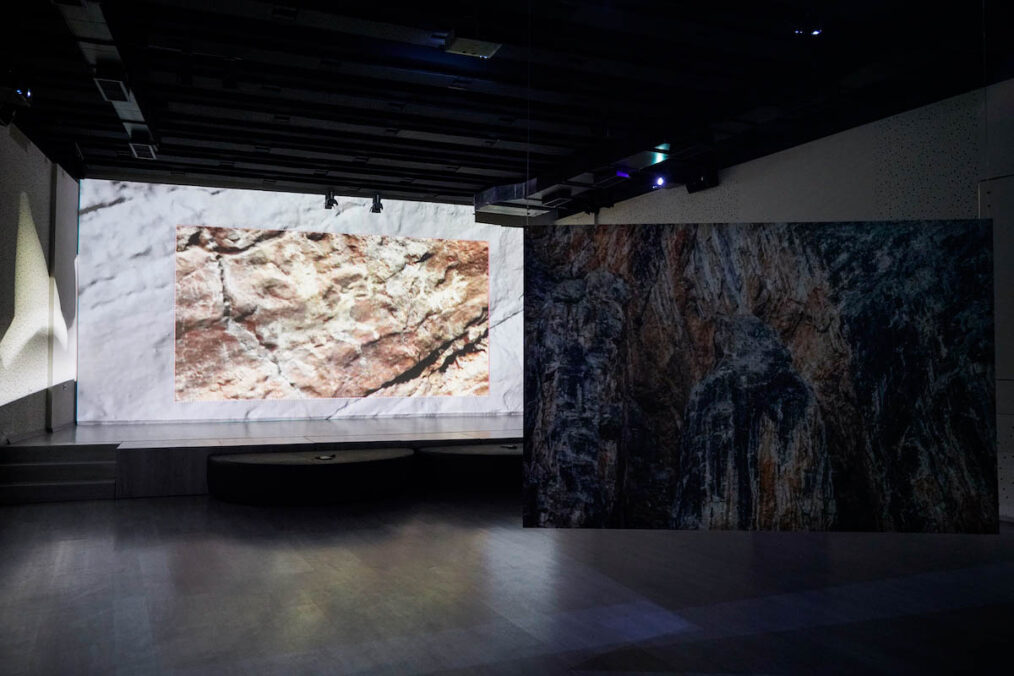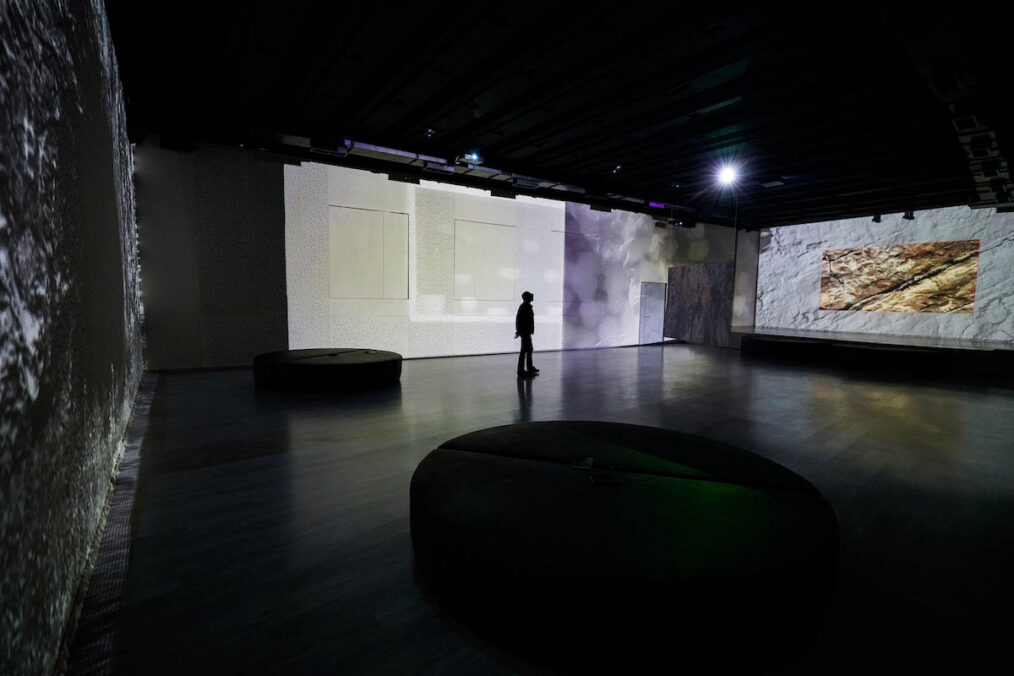The concept of “Performative Exhibition” aims to find new ways of exhibiting and curating which break with the temporary / unique features of the contemporary exhibition and propose enduring ways of working together. For Performative Exhibition #4 – Written Cave, a diverse group of Albanian and international artists—across disciplines and generations—gathers at the Gallery of Digital Korça. After an immersive research phase in the Korça region, the artists have developed new works inspired by two significant prehistoric sites.
„Performative Exhibition #4 – Written Cave“ brings together the works of four contemporary artists from different disciplines and generations: Enza Rripaj, Abi Shehu, Vasil Tole, and Alexander Walmsley. At the core of the created art works, is the archaeological richness of the Korça and Devoll regions. During the prehistoric era, the entire area of Korça and Devoll experienced significant human life development, which is still reflected today in the numerous settlements in this geographical area. Part of this map are also two archaeological sites, which are indicative of our cultural heritage: the rock paintings in the Written Cave and the settlement in the cave of Tren across from Small Prespa Lake.


According to studies, the Tren cave has been used almost continuously as a settlement for 3 millennia, starting from the Neolithic era (7000-3000 BC) until the Early Middle Age (6th-7th centuries AD), while the rock painting of the Written Cave, which is located just a few hundred meters from the cave, dates back to the Bronze Age, around 3,500 years ago. The rock painting depicts a hunting scene, where people stand out riding horses, armed with spears and accompanied by dogs, who are together chasing a deer. Thanks to the content it carries, the painting is valued as a unique example of prehistoric art for the entire Balkan region.
Furthermore, the natural landscape surrounding the archaeological sites is part of the Prespa National Park, home to a number of rare species and a diverse flora, providing a breathtaking panorama. In August of this year, a group of artists and curators conducted a research phase in the Korça and Devoll area with the aim of creating new artistic works.
The result of this engagement is Performative Exhibition #4 where virtual reality, video, music, photography, installation and text intersect. Drawing inspiration from archaeology and prehistory, as well as the reintroduction of their elements through the perspective of contemporary art, is a great opportunity for engaging with cultural heritage, especially that important part located in peripheral and not easily accessible spaces.

In conceptual terms, Performative Exhibition #4 – Written Cave explores the relationship between the symbolism of the cave (habitat) and writing (sign) by reintroducing these archaic elements with new means. The exhibition explores the importance of language as an agency to transmit archaic forms of communication. The concept aligns with the theory of Swiss structuralist philosopher Ferdinand de Saussure (1857-1913), whose ideas in the field of semiology present a bilateral interpretation of signs as a communicative act that separates the signifier, which can be a word, an image, or a sound, and on the other hand, the signified, or in other words, the meaning conveyed. The written epithet (as in Written Cave) emerges as a form of communication in pre-alphabetic societies, where alphabetical writing was not known, but the message was transmitted through various signs and images, which transformed are displayed today after a long journey through time. Through the created works, the diachronic relationship between ancient and contemporary motives is explored, intertwining the symbolism of the cave as a habitat and a transition from light to darkness, from inside out, as well as marking as a communicative and transferable act.

Enza Rripaj
A Drop of Light, 2024 Audio , 3’25”
Text and drawings printed on a booklet. 10,5×14,85cm
Enza Rripaj presents the text titled A Drop of Light. The focus of the text is an imaginary narrative about the chronological tension heading towards a temporary dissolution of reality and, on the other hand, eternity and permanence. This tension is caused by the light dripping inside the dark cave as the sublime truth that concentrates an extraordinary power. Rripaj’s dual-texture gathers timeless time as an arbitrary force against the darkness that is moving from the cave towards the Rock Paintings and confronting the figure of the deer. The symbolism used gives to the image of the deer an aura of delicacy and elegance; metaphorically interacting with human tears in the form of light that reflect in the eyes of the deer, they become eternal against the infamous darkness. The imaginary worldview constructs a vertical and horizontal axis, where respectively the underworld and overworld, cave and meta-cave, accompany the entire contrastive and metaphorical narrative of the artist. Rripaj’s text is dictated by the voice of the artist herself between the two musical parts of Vasil Toles playing in the background. A booklet with the text ‚A Drop of Light‘ and drawings inspired by the Rock Paintings are also part of the exhibition.
Abi Shehu
Untitled, 2024
Two digital printed photographs on aluminum. 150×224 cm
The work of Abi Shehu Untitled consists of two images displayed on both sides of a surface hanging in space, giving the idea of a projected screen. The images are aesthetically striking for the geomorphological motifs they convey. The images document an interior view of the Tren Cave and the view of the rugged relief where the Rock Painting and the Written Cave are located. As contemporary philosopher Nathan Andersen addresses, there is a connection between the cave and cinema in the context of Plato’s allegory of the cave. The cave should be seen as a cinema screen, which from within reflects images in intermediate forms, filled with stratifications, folds, breaks, stalactites, which together metaphorically constitute a spectacle of characters and
stage movements. Considering the shadows in Plato’s allegory, Shehu’s work develops between the real and the imaginary through the communicative power of abstract images that manifest on the walls of the cave. The pursuit of knowledge and truth is a process that passes through the linguistic dialogue of signs, a role also played by the cinema screen.


Vasil S. Tole
Shatra-Patra, 1997 Piece for percussion instruments, 2’44’’
A Psalmodiae Bono, 1999 Piece for string orchestra, 6’19”
Vasil S. Tole contributes with two musical compositions that are part of his repertoire, specifically: Shatra-Patra and A Psalmodiae Bono. It is precisely during the Neolithic era, when human society begins to settle in permanent settlements and form a complex society, moving away from the shatra-patra way of living only as hunter-gatherers. Percussion instruments are among the earliest instruments that humans have created as a means to communicate through music. Shatra-Patra begins as a collective call that comes from the depth of the cave, the echo of which awakens in a fundamentally rhythmic way the feeling of a distant time, embodying anxiety, mystery, and curiosity. The use of a variety of percussion instruments creates a rich palette and often with rhythmic contrasts, developing a lively and interactive dialogue. The background music undergoes an intermezzo from the dictated text of Enza Rripajt, and then the sounds of the harp orchestra of A Psalmodiae Bono provide a more lyrical nature, a more liberated emotional landscape, but with unexpected changes in tempo and dynamics that help convey flowing emotions. Transitioning from gentle passages to lively ones, the composition encourages thinking and exploring the spatial and temporal dimension towards elevation and enlightenment.

Alexander Walmsley
Hollow Earth, 2024, 6 channel Video Installation, no sound, 10’32’’
Hollow Earth by Alexander Walmsley is a looped video installation composed of 5 video channels documenting the artist’s journey in the Korça and Devoll area, using a depth filter filming technique. The video installation interwines the history of the area with Walmsley’s own history, where he returns to the perspective acquired from archaeological studies and where archaeological excavations took a prominent place. These are fragments of images from prehistory with which Walmsley is confronted again in Korça: ceramic vessels, tools, bones, various ornaments, which have traveled through time to find a place in a museum or wait, this time not for the mastery of the archaeologist to be revealed from the underground, but for the artist’s eye to shed light of attention. On the other hand, archaeology cannot be fully understood without considering the natural environment that surrounds it. Landscape archaeology as a determinant of human life during prehistory also invites us to be for a few moments part of its past as prehistoric cave dwellers, while today in the present, witnesses of the role of archaeology in shaping identity narratives. Finally, on the sixth screen, through 3D scanning technique, Walmsley has documented in a photorealistic way the rock painting in the Written Cave, virtually giving it a tangible and more touchable form, bringing this piece of cultural heritage closer to the public.
Performative Exhibition #4 – Written Cave
Featuring: Enza Rripaj, Abi Shehu, Vasil Tole, Alexander Walmsley
Curated by: Adela Demetja and Fabio Toska
Exhibition duration: 19. October – 3. November
Address and contact:
Galeria Arteve Digjitale Korce
Bulevardi Republika, Korçë 7000, Albania
www.gadk.al
Tirana Art Lab – www.tiranaartlab.org
Note: Performative Exhibition #4 is a collaboration between Tirana Art Lab and the Gallery of Digital Arts Korçë. This project is supported by the Ministry of Economy, Culture, and Innovation. The research phase and the travel of Alexander Walmsley was supported by Culture Moves Europe, a project funded by the European Union.






